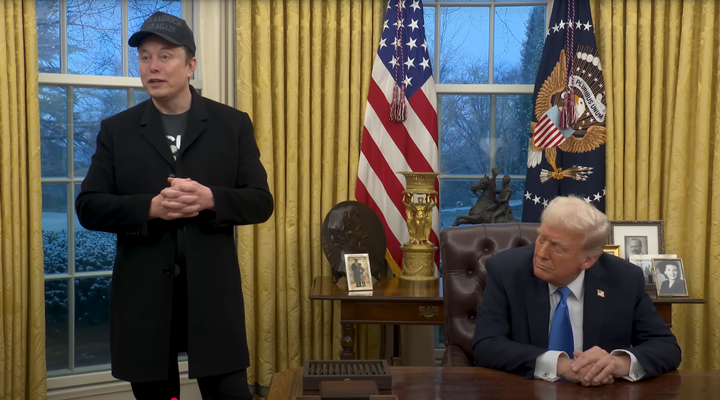Elon Musk's DOGE Reportedly Installed AI To Root Out 'Disloyal' Government Employees

The following article was made possible by paid subscribers of The Dissenter. Become a subscriber and support independent journalism on whistleblowers and freedom of the press.
Two people familiar with the use of technology by Elon Musk’s DOGE team told Reuters that the team has setup artificial intelligence to spy on employees at the Environmental Protection Agency (EPA).
The objective, according to the two media sources, is to look for “language in communications considered hostile” to Musk or President Donald Trump.
“Trump-appointed officials who had taken up EPA posts told managers that DOGE was using AI to monitor communication apps and software, including Microsoft Teams, which is widely used for virtual calls and chats,” the sources additionally claimed.
“We have been told they are looking for anti-Trump or anti-Musk language,” a third source familiar with the EPA said to Reuters.
Most likely the EPA is not the only agency where Musk has rolled out AI-powered surveillance, but at the moment, its use at other agencies has not been confirmed.
If the DOGE team overseen by the world’s richest man truly has installed AI to root out employees who are perceived to be disloyal, that is remarkable. AI could easily be utilized to identify media sources. Yet such monitoring is not without precedent.
Over the past 10-15 years, several government agencies have developed policies and installed technology to root out supposed “insider threats.”
President Barack Obama issued an executive order on October 7, 2011, in the aftermath of United States Army whistleblower Chelsea Manning’s disclosures of information to WikiLeaks. The order established the Insider Threat Program.
A 2015 report from McClatchy Newspapers examined how the program expanded beyond protecting U.S. national security to monitoring “most federal departments and agencies nationwide, including the Peace Corps, the Social Security Administration and the Education and Agriculture departments.” The program could be utilized by agency heads to penalize a range of conduct in addition to leaks of information.
“Behavior profiles” were developed for government employees, and “current and former officials and experts” warned that the program “could make it easier for the government to stifle the flow of unclassified and potentially vital information to the public, while creating toxic work environments poisoned by unfounded suspicions and spurious investigations of loyal Americans.”
In 2016, Matt Fuller, in a series for the whistleblower advocacy organization known as the Government Accountability Project, wrote, “The Insider Threat Program is single-mindedly pursuing a course that seeks to deter, detect and punish whistleblowing, even within designated channels. This strategy ignores the numbers of workers who are not attempting to sell state secrets, but are instead seeking to draw attention to corruption or wrongdoing within the agency.”
“Constant employee surveillance will only create an atmosphere of fear and suspicion and prevent speaking up, or even speaking to a coworker or to Congressional Intelligence Committees,” Fuller added.
The Insider Threat Program received renewed support in 2013 after NSA whistleblower Edward Snowden exposed mass surveillance programs—several of which involved the unlawful collection of Americans’ communications data.
In 2014, the Associated Press reported that U.S. intelligence officials were “planning a sweeping system of electronic monitoring that would tap into government, financial and other databases to scan the behavior of many of the 5 million federal employees with secret clearances,” according to "current and former officials.”
Director of National Intelligence James Clapper told Congress, “What we need is a system of continuous evaluation where when someone is in the system and they’re cleared initially, then we have a way of monitoring their behavior, both their electronic behavior on the job as well as off the job.”
As The Dissenter covered in January 2016, the Defense Department developed an Automated Continuing Evaluation System (ACES) that enabled the total surveillance of personnel by conducting “point-in-time records checks” and pulling data from “trusted data sources.”
At least a hundred thousand military, civilian, and contractor personnel were subjected to this total surveillance, which was part of the Insider Threat Program.
Lee Tien, who was a senior staff attorney at the Electronic Frontier Foundation, warned “workers’ free speech, political allegiances and outside activities could be chilled under the threat of constant monitoring. Some workers might face scrutiny because of inaccurate reporting.”
Despite multiple years of investigations and congressional proceedings into the “weaponization of government” under President Joe Biden, Trump and Republicans seem largely unconcerned about how surveillance could be directed by Musk and DOGE against government employees, including potential whistleblowers and media sources.
On April 4, Public Employees for Environmental Responsibility (PEER) called attention to an EPA memo that indicated EPA employees were offered “internet access for personal mobile phones, laptops, and other devices.” Use of the network would be solely for “personal (non-EPA-issued) devices.”
The “Wi-Fi network” for the “EPA Workforce” is apparently operated by Starlink, a subsidiary of Musk’s SpaceX.
“EPA employees should not take advantage of this free service,” declared PEER Science Policy Director Kyla Bennett, a scientist and attorney who once worked at the EPA. “Through this connection, EPA will be able compile data and information on their employees’ personal internet usage.”
Using this WiFi network will enable the EPA to “track what internet sites employees visit on their own time and compose profiles of workers with interests that would raise suspicions of current Trump-appointed overseers”—much like the Insider Threat Program that Obama first established.




Comments ()